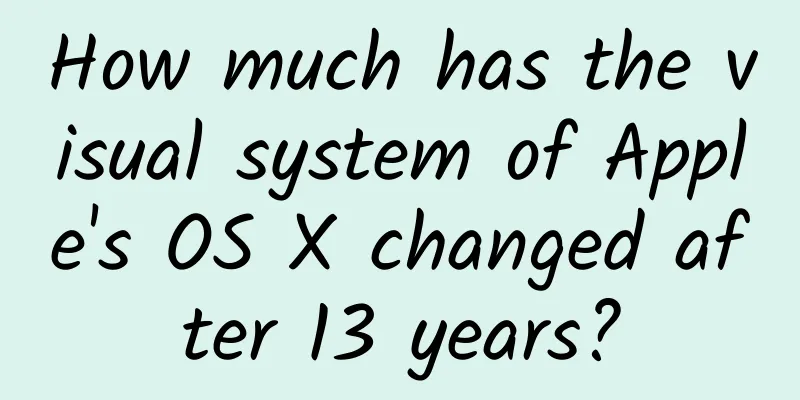How much has the visual system of Apple's OS X changed after 13 years?

|
After a long beta period, OS X 10.10 Yosemite is now available for download. This is the 11th version of Apple's OS X, and it is also the biggest change in the design of OS X since its birth in 2001. Maybe you are updating to this new operating system at this moment, so while you are waiting, let's review the changes of this operating system in the past 13 years. Mac OS 9 Before OS X, Apple released Mac OS 9 in 1999, which laid the foundation for the overall design of the Mac system. OS X 10.0 OS X 10.0 was released in 2001. Codenamed "Cheetah" internally, it represented a new era for Apple. It was released five years after Steve Jobs returned to Apple and incorporated technology from NeXT. It was a Unix-like operating system that remains the foundation of OS X to this day. As the company changed, the operating system also received a new graphical interface. This system added many graphical user interaction elements, such as round window control buttons and translucent and reflective effects. This version also added the Dock bar for the first time. "Cheetah" is an operating system with many problems. In addition to high system configuration requirements, users have complained about its compatibility, stability and performance. OSX10.1 Six months after the release of OS X 10.0, Apple released 10.1 Puma. In this version, Apple fixed many problems in 10.0. Puma brought better performance and stability, as well as better support for DVD playback and CD and DVD burning. 10.1 is free for 10.0 users. OS X 10.2 Jaguar Released in August 2002, Jaguar was the first version of OS X to be named after its development code name, rather than simply a number. In addition to performance and stability improvements, 10.2 introduced Apple's email client "Mail", IM client iChat, Contacts, and support for the MPEG-4 format through QuickTime 6. Jaguar also supports CUPS, a printing tool that allows any OS X device to act as a print server, and Rendezvous, which facilitates communication between devices on a network. Rendezvous is now known as Bonjour, and is the basis for features such as iTunes music sharing. Apple debuted its Safari browser for the Jaguar. OS X 10.3 Panther Panther was released in October 2003. This update was mainly aimed at the user interface, which included many new Apple hardware design elements. The brushed metal design was a natural match for the anodized aluminum PowerBook. Exposé (now Mission Control) debuted on Panther, giving users a quicker way to switch between windows. iChat introduced audio and video conferencing. Panther replaced Microsoft's Internet Explorer with Safari as the default browser for the first time. OS X 10.4 Tiger Tiger was released in April 2005, bringing with it a rich set of new tools. The most important tools were Spotlight, Apple's system-wide search application; Dashboard, an application layer that supports simple widgets; Automator, a simple scripting tool that automates tasks; and version 2.0 of the Safari browser and Mail application. In early 2006, Tiger became the first consumer version of OS X to support Intel processors. At that time, Apple computers had been using IBM's PowerPC architecture processors for nearly a decade. OS X 10.5 Leopard In 2007, Apple released Leopard. It was two years between the last version, and Apple told us that 10.5 was worth the wait. This version had a lot of visual enhancements, including a new 3D Dock and a smooth texture instead of aluminum, and the current desktop background color could be displayed on the translucent menu bar. Apple introduced more than 300 new features for Leopard, the most important of which should be Time Machine, a backup tool that allows users to access deleted files. It also includes Spaces, a feature that allows users to create multiple "virtual desktops." Quick Look allows users to preview files without opening them in an application. For Intel users, Apple introduced Boot Camp, which allows people to install Windows operating systems on Mac OS X systems. OS X 10.6 Snow Leopard After 15 years, Apple completely abandoned the Power PC architecture processor and released computers using Intel chips and pre-installed Snow Leopard operating system in 2009. As its name suggests, Snow Leopard is mainly focused on improving the core experience of Leopard rather than adding new features. Most of the built-in software has been rewritten to improve performance and efficiency, which makes Snow Leopard take up 7GB less system space than Leopard. OS X 10.7 Lion As the iPhone and iPad became popular products for consumers, Apple incorporated many elements of iOS into OS X Lion, which was released in 2011. Most notable are Launchpad, which brings an interface similar to iOS that displays all the computer's applications in a grid; Lion adds full-screen mode, which allows users to run applications in a separate space outside of desktop mode; FaceTime, a feature first introduced on the iPhone 4, is now brought to the desktop; the Mac App Store also debuts; Time Machine can now save a previous version of a file; and AirDrop allows users to share files between different Macs via Wi-Fi. OS X 10.8 Mountain Lion Like Snow Leopard before it, Mountain Lion, released in 2012, is also a version that improves the previous generation of OS X. However, the focus of 10.8 is to enhance the interaction between devices. iCloud integration allows users to share certain files between iOS and OS X. Apple has launched more iOS-specific applications, such as Game Center, Reminders, Memos, and Notification Center. Other notable updates include the ability to mirror your computer screen to your Apple TV via AirPlay, as well as Twitter and Facebook integration. OS X 10.9 Mavericks Apple bid farewell to big cats in its 10.9 naming system, and instead named its operating system after California landmarks. Despite the new name, Mavericks is still a regular update. It was announced on the same day as the redesigned iOS 7, and Mavericks still has a skeuomorphic design. Its main features include further integration of iCloud, especially the introduction of iCloud Keychain, a function that automatically remembers user passwords; more applications are closer to iOS design, such as iBooks and Maps; and battery life has been significantly improved in this version. Any Mac running Snow Leopard or higher can be upgraded to Mavericks for free through the Mac App Store. Users who buy Apple computers pre-installed with Mavericks can also get the three iWork suites for free. OS X 10.10 Yosemite OS X 10.10 Yosemite is the biggest visual change in Apple's operating system in many years. In addition to the interface changes, it also adds new features such as Continuity, Handoff and the new Spotlight. Link to this article: http://linux.cn/article-4033-1.html |
<<: The battle to protect smart homes begins with Google's acquisition of Dropcam
>>: The story Intel and Linux have to tell
Recommend
Do "intermittent fasting", "quitting dinner" and "cutting carbs" really work? The new version of the national weight loss guide is here!
Recently, the National Health Commission released...
Surprise! It turns out that the plasticine we played with as children was actually used to build tanks
Did you know that science is full of happy accide...
What's so special about the robots that scientists were inspired to create by this fish?
Produced by: Science Popularization China Author:...
Is it better to eat beef or pork? I didn't expect to have been eating the wrong one all along →
For meat lovers, pork and beef are probably indis...
World Food Safety Day | Will you get "lychee disease" if you eat lychees on an empty stomach? Will you get a "beer belly" if you drink beer regularly? The truth is...
There are many popular myths about food health, a...
7 Nobel Prize winners gathered at the West Lake, and the most talked about topic was whether you and I could keep our jobs.
In order to find out the reason why some strange ...
There are 4 Guineas in the world. Can you tell which coup is which?
This article was first published by Hunzhi (WeCha...
How to avoid "making things worse" in brand crisis public relations?
Introduction: "There is an important role in...
Why do humans love kissing? This may be the scientific explanation for the "love brain"...
When we are immersed in the romantic moment of ki...
Houchang College Zhao Yang Integrated Marketing Director Training 8-session Video Course (Completed)
Houchang College Zhao Yang’s 8-session video cour...
Interpretation of the user incentive system of Station B
This article will start from the perspective of B...
Xiaopeng Motors G3 will be launched this spring, and the OEM is finally not JAC
Nowadays, the decline of subsidies for new energy...
People who are afraid of cold are not afraid of heat? Beware: The cultural disease of fear of cold can really kill you!
Author: Dr. Li Changqing, a practicing physician ...
Offline operation promotion: 28 ways to attract new customers!
Today I will introduce to you offline methods of ...
Double 11+ KOL advertising trends and influencer marketing in 2021
Insight report on the 2021 Double 11+ KOL adverti...









